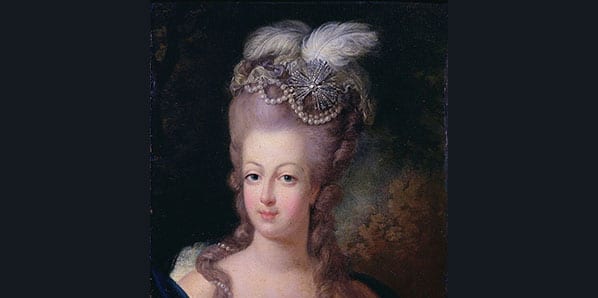 The woman known to history as Marie Antoinette was born in Vienna in 1755. As the 15th child of Empress Maria Theresa, the infant immediately became an archduchess of Austria and was given the baptismal name Maria Antonia Josepha Johanna.
The woman known to history as Marie Antoinette was born in Vienna in 1755. As the 15th child of Empress Maria Theresa, the infant immediately became an archduchess of Austria and was given the baptismal name Maria Antonia Josepha Johanna.
At the age of 14, she was married to the heir to the French throne in one of those political marriages common among European royal houses. The union had nothing to do with romance – due to the groom’s inability or disinterest, it apparently wasn’t consummated for over seven years. Still, she was queen of France before turning 20.
But what may have seemed like a charmed life came to a dismal end when she went to the guillotine on Oct. 16, 1793, just shy of her 38th birthday. The shabby nature of her demise reflected no credit on her executioners.
Antonia Fraser’s generally sympathetic 2001 biography sees Marie Antoinette as more sinned against than sinning. While not gainsaying the Queen’s penchant for frivolity and extravagance, she believes that “many of her sins were venial.”
Unprepared at the age of 14, Marie Antoinette was dispatched to Paris to play a role that was beyond her training and perhaps her inherent ability. And the weak man she married was no help.
Over time, she became the all-purpose scapegoat for everything that ailed pre-revolutionary France. In addition to being a financial wastrel, “the Austrian woman” was allegedly the evil manipulator behind the throne and the agent of a foreign power.
A substantial part of the demonization related to purported sexual activity. Rumours claimed that Marie Antoinette was simultaneously a rampant adulteress, an insatiable orgy participant, a lesbian and an incestuous abuser of her son. Much of this scurrilous material made it into print.
Fraser, though, isn’t impressed. The only extramarital activity she ascribes to the queen is a probable affair with the Swedish aristocrat Count Axel von Fersen, guessing that it began in 1783. Fersen, although involved with other women, remained devoted to the queen for the rest of her life and made various futile efforts to save her.
By the time Marie Antoinette went to trial in October 1793, her fate was already determined.
Jacques Hebert, the radical journalist and revolutionary, had made his position clear at a secret meeting of the Committee of Public Safety: “I have promised the head of Antoinette. I will go and cut it off myself if there is any delay in giving it to me.” Her public decapitation was to be a gift to the mob.
The formal trial began on the morning of Oct. 14. Just over 52 hours later, she was dead.
Fraser contrasts the treatment of Marie Antoinette with that of her husband, Louis XVI. He’d been executed nine months earlier.
Whereas Louis was given time to prepare a legal defence, no such consideration was provided to her. She didn’t meet her lawyers until the day before the trial commenced and her request for a delay in the proceedings was ignored.
Louis was conveyed to the scaffold in a dignified carriage, but she travelled the final journey in an open cart with her arms bound behind her and her hair hacked off. Humiliation was the intended order of the day.
And while Louis was accompanied by a friendly priest, she was denied that consolation. There was no mercy for “the Austrian woman.”
By all accounts, she died bravely.
Mind you, some people interpreted her composure as just another example of haughtiness, arrogance and disdain. In Hebert’s telling, she was “audacious and insolent to the end.”
Others took a different view. There were even those partisans who found it inspirational, a tribute to her “great soul” an “the illustrious blood of the House of Austria.”
After the monarchical restoration following Napoleon’s defeat, the bodies of Marie Antoinette and Louis were exhumed from the graves where they’d been unceremoniously buried. Duly sealed in new coffins, they were then transferred to the traditional royal necropolis in the cathedral of Saint-Denis. It’s in a northern suburb of Paris and well worth a visit.
A final note: If Marie Antoinette died with dignity, the same can’t be said for her biggest tormentor. As the revolution progressively devoured its own, Hebert went screaming to the guillotine less than six months after her execution.
Perhaps there’s really such a thing as karma.
Troy Media columnist Pat Murphy casts a history buff’s eye at the goings-on in our world. Never cynical – well perhaps a little bit.
The views, opinions and positions expressed by columnists and contributors are the author’s alone. They do not inherently or expressly reflect the views, opinions and/or positions of our publication.


